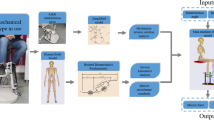Abstract
Ankle rehabilitation exercise therapy mainly includes passive, active, and resistance rehabilitations. Active rehabilitation exercise is highly important during ankle rehabilitation, how to combine the ankle and the rehabilitation robot has elicited considerable research attention. This paper proposed a combination strategy for the ankle and the rehabilitation robot based on a 3D modeling of the ankle and the robot developed individually based on simulation software (AnyBody). By integrating the 3D models of the human body and the robot, setting constraints between the pedal of the robot and the pelma of the human body and the degrees of freedom of the ankle is constrained as 3, a man-machine integration model for ankle active rehabilitation strategy analysis was established. Then, human muscle characteristics were established under the combination of different variables and the range of ankle motion were carried out by the human body active movement with ankle plantar/dorsal flexion motion, this further leads to strategies for ankle active rehabilitation. Finally, this paper designs the driving function for the robot based on Fourier function, and the force condition for the ankle movement during rehabilitation exercise was evaluated from the perspective of biomechanics. This study would provide a fundamental reference for the further formulation of active rehabilitation strategies and the control of rehabilitation robots.
Similar content being viewed by others
References
Zhang, M., Claire, D.T., Xie, S.: Effectiveness of robot-assisted therapy on ankle rehabili-tation – a systematic review. J. Neuroengineering Rehabil. 10(1), 30 (2013)
Wang, J.: Rehabilitation of ankle joint and foot. Chin. Rehabil. Theor. Pract. 14(12), 1197–1198 (2008)
Girone, M.J., Burdea, G.C., Bouzit, M.: Rutgers ankle orthopedic rehabilitation interface. ASME Dyn. Syst. Control Div. DSC 67, 305–312 (1999)
Dai, J.S., Zhao, T., Nester, C.: Sprained ankle physiotherapy based mechanism synthesis and stiffness analysis of a robotic rehabilitation device. Auton. Robots 16, 207–218 (2004)
Saglia, J.A., Dai, J.S., Caldwell, D.G.: Geometry and kinematic analysis of a redundantly actuated parallel mechanism that eliminates singularities and improves dexterity. J. Mech. Des. 130(12), 1786–1787 (2008)
Takemura, H., Onodera, T., Ding, M., et al.: Design and control of a wearable stewart plat-form-type ankle-foot assistive device. Int. J. Adv. Robot. Syst. 9, 1–7 (2012)
Xie, S.Q., Jamwal, P.K.: An iterative fuzzy controller for pneumatic muscle driven reha-bilitation robot. Expert Syst. Appl. Int. J. 38(7), 8128–8137 (2011)
Agrawal, A., Sangwan, V., Banala, S.K., Agrawal, S.K., Stuart, A.: Binder-macleod, de-sign of a novel two degree-of-freedom ankle-foot orthosis. J. Mech. Des. 129, 1137–1143 (2007)
Yoon, J., Ryu, J.: A novel reconfigurable ankle/foot rehabilitation robot. In: Proceedings of the 2005 IEEE International Conference on Robotics and Automation, Barcelona, Spain, pp. 2290–2295 (2005)
Yoon, J., Ryu, J., Lim, K.S.: Reconfigurable ankle rehabilitation robot for various exercises. J. Robot. Syst. 22, S16–S33 (2006)
Yu, H.: Design of parallel ankle rehabilitation robot system. YanShan University (2006)
Liu, G., Gao, J., Yue, H., et al.: Design and kinematics analysis of parallel robots for ankle rehabilitation intelligent robots and systems. In: 2006 IEEE/RSJ International Conference on IEEE, pp. 253–258 (2006)
Zhang, L.X., Sun, H.Y., Qian, Z.M.: Kinematics analysis and simulation of horizontal lower limbs rehabilitative robot. J. Syst. Simul. 22(8), 2001–2005 (2010)
Warnica, M.J., Weaver, T.B., Prentice, S.D., et al.: The influence of ankle muscle activation on postural sway during quiet stance. Gait Posture 39(4), 1115–1121 (2014)
Weaver, T.B., Glinka, M.N., Laing, A.C.: Stooping, crouching, and standing – characterizing balance control strategies across postures. J. Biomech. 53, 90–96 (2017)
Hisashi, N., Yasushi, A., Ayu, M., et al.: Identification of individual muscle length parameters from measurements of passive joint moment around the ankle joint. J. Biomech. Sci. Eng. 7(2), 168–176 (2012)
Robertson, B.D., Sawicki, G.S.: Influence of parallel spring-loaded exoskeleton on ankle muscle-tendon dynamics during simulated human hopping. In: 33rd Annual International Conference of the IEEE EMBS, Boston, Massachusetts, USA, pp. 583–586, 30 August–3 September 2011
Cheung, J.T., Zhang, M., Leung, A.K., et al.: Three—dimensional finite element an analysis of the foot during standing-a material sensitivity study. J. Biomech. 38(5), 1045–1054 (2005)
Zhang, Q.X., Zhang, L., Wang, G.X.: Effect of local muscle fatigue on the proprioception of the ankle joint. Chin. Sport Sci. 31(3), 68–74 (2011)
Zhang, Q.X.: The test-retest reliability of ankle muscle force perception with different target moments. In: Conference of the Fourteenth National Conference on Sports Bio-Mechanics, pp. 404–407 (2010)
Zhang, Q.X., Zhang, L.: The test-retest reliability of ankle joint position and the perception of muscle force. J. Clin. Rehabil. Tissue Eng. Res. 14(35), 6520–6524 (2010)
Tang, G.: Simulation analysis of human body based on biomechanics. In: Shanghai: School of Mechanical and Power Engineering, Shanghai Jiao Tong University (2011)
Jin, Y., Tang, Z.: Analysis of the causes of the injury from the anatomical structure of the ankle joint. Phys. Educ. Rev. 35(7), 87, 88 (2016)
Liu, Y., Zhou, S.Y., Zhen, Y.J., et al.: Effects of gastrocnemius muscle force on foot bio-mechanics based on finite element analysis. J. Med. Biomech. 31(5), 37–442 (2016)
Author information
Authors and Affiliations
Corresponding authors
Editor information
Editors and Affiliations
Rights and permissions
Copyright information
© 2017 Springer International Publishing AG
About this paper
Cite this paper
Liao, Z., Lu, Z., Peng, C., Li, Y., Zhang, J., Yao, L. (2017). Ankle Active Rehabilitation Strategies Analysis Based on the Characteristics of Human and Robotic Integrated Biomechanics Simulation. In: Huang, Y., Wu, H., Liu, H., Yin, Z. (eds) Intelligent Robotics and Applications. ICIRA 2017. Lecture Notes in Computer Science(), vol 10462. Springer, Cham. https://doi.org/10.1007/978-3-319-65289-4_1
Download citation
DOI: https://doi.org/10.1007/978-3-319-65289-4_1
Published:
Publisher Name: Springer, Cham
Print ISBN: 978-3-319-65288-7
Online ISBN: 978-3-319-65289-4
eBook Packages: Computer ScienceComputer Science (R0)




